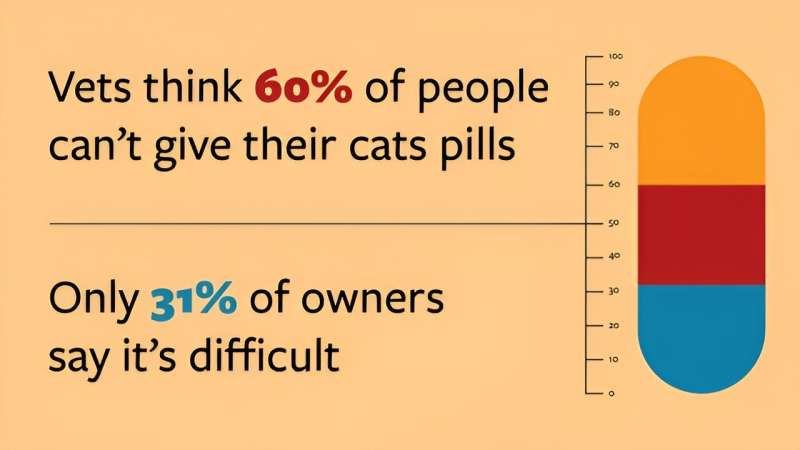This article has been reviewed according to Science X's editorial process and policies. Editors have highlighted the following attributes while ensuring the content's credibility:
fact-checked
peer-reviewed publication
trusted source
proofread
Education is key to curbing antimicrobial resistance in cats, study says

Better education for cat owners, more communication from veterinarians, increased drug choices and cheaper, rapid diagnostic tools can help improve antimicrobial use in cats, which has important implications for rising antimicrobial resistance in animals and humans, according to two new papers by Cornell researchers.
Antimicrobial resistance threatens up to 10 million human lives a year and may cost the global economy trillions of dollars, with resistant pathogens moving easily between humans and animals, according to the papers' authors.
In a recent paper, "Divergent Veterinarian and Cat Owner Perspectives are a Barrier to Reducing the Use of Cefovecin in Cats," published online Nov. 1 in the Journal of the American Veterinary Medical Association (JAVMA), the researchers conducted surveys to tease apart how cat owners' and veterinarians' views may each be contributing to overuse of the only long-acting, injectable antimicrobial for use in cats, called cefovecin.
While cefovecin is broad-spectrum and more convenient to administer, oral antimicrobials can be cheaper, more narrow-spectrum and provide a shorter length of treatment. That's important because long-term exposure to antibiotics gives pathogens more opportunities to gain resistance.
"I could give only three to five days of pills for a urinary tract infection versus an injection of cefovecin, which lasts for seven or more days at effective concentrations, but persists at subtherapeutic levels for two months," said lead author of the study, Casey Cazer, DVM, an assistant professor in the Department of Clinical Sciences and the associate hospital director of the Small Animal Community Practice Service in the College of Veterinary Medicine (CVM).
It can be a challenge to get cats to take oral medications, though veterinarians believe cat owners struggle more than they do. According to the survey, veterinarians estimated that 60% of cat owners found it difficult to medicate their cats and 20% found it impossible. On the other hand, fewer cat owners reported having at least one cat for whom they struggled to administer pills (31% reported difficulty and 9% found it impossible) or liquid medications (20% reported difficulty and 5% said it was impossible).
"If veterinarians are thinking 'most of my clients can't medicate their cats," then they are more likely to give the more intense, 'bigger gun' [the shot of cefovecin]," said Amelia Greiner Safi, M.S., a professor of social and behavioral sciences and public health practice in the Department of Public and Ecosystem Health (CVM), who is a senior author of the paper.
The survey also revealed that some veterinarians believed older cat owners would struggle with administering oral medications, a bias not backed up by cat owners themselves.
When cat owners did struggle to restrain their cats or got scratched and couldn't administer oral medication, only 65% talked to their veterinarians afterwards about how to better give their cats medication, even though they generally trusted their veterinarians as sources of information about cat health.

"If there's an area where we can help veterinarians anticipate cat owner needs, because cat owners might not communicate, we can be proactive in training cat owners and help them be more successful in giving oral medication that is less problematic for antibiotic resistance," Cazer said.
Importantly, cat owners were also open to being educated about risks and benefits of different antibiotics. Given a choice between an injection, pills or liquid, about three in four cat owners said they preferred the injection. But when they were then informed that the injection could lead to antimicrobial resistance that threatens animals and humans, three in four were willing to try an oral medication.
"It highlights that we can, as veterinarians, educate cat owners and help them make better choices when it comes to antibiotic use," Cazer said. A simple demonstration in restraining and successfully administering oral medications could reduce cefovecin use, according to the authors.
Veterinarians' understanding of their own role in the problem of antimicrobial resistance varied, with some knowing the general risks but downplaying their own roles in contributing to it. Previous research has shown that the general public has a limited understanding of antimicrobial resistance.
Veterinarians also reported that they may succumb to giving cefovecin when they are concerned about comorbidities in older cats, when clients refuse expensive diagnostic tests, when they are uncertain about treatments, and when clients are pushy.
Diagnostic testing guides proper antibiotic choices and is a vital tool for antimicrobial stewardship. Veterinarians and clients may decline testing because it is time consuming and costly, averaging close to $160 for a bacterial culture and sensitivity test in 2021. Without testing, cefovecin can be perceived as the simplest alternative, even if not ideal.
A companion overview paper led by Cazer and Safi, "Pathways to Sustainable Antimicrobial Use in Cats," also published Nov. 1 in JAVMA, provides an overview of the issues and ways to prevent antimicrobial resistance. These include faster, cheaper diagnostic testing, development of new antimicrobials and better education and training of veterinarians and cat owners.
Co-authors on both papers include Ameila Frye M.P.H., and Lecsy Gonzalez M.P.H., and research assistant Jeanne Lawless Ph.D., in the Department of Public and Ecosystem Health. Claudia Cobo-Angel, a postdoctoral researcher (CVM), is a co-author of the overview paper.
More information: Casey L. Cazer et al, Divergent veterinarian and cat owner perspectives are barriers to reducing the use of cefovecin in cats, Journal of the American Veterinary Medical Association (2023). DOI: 10.2460/javma.23.08.0487
Casey L. Cazer et al, Pathways to sustainable antimicrobial use in cats, Journal of the American Veterinary Medical Association (2023). DOI: 10.2460/javma.23.08.0481
Journal information: Journal of the American Veterinary Medical Association
Provided by Cornell University


















